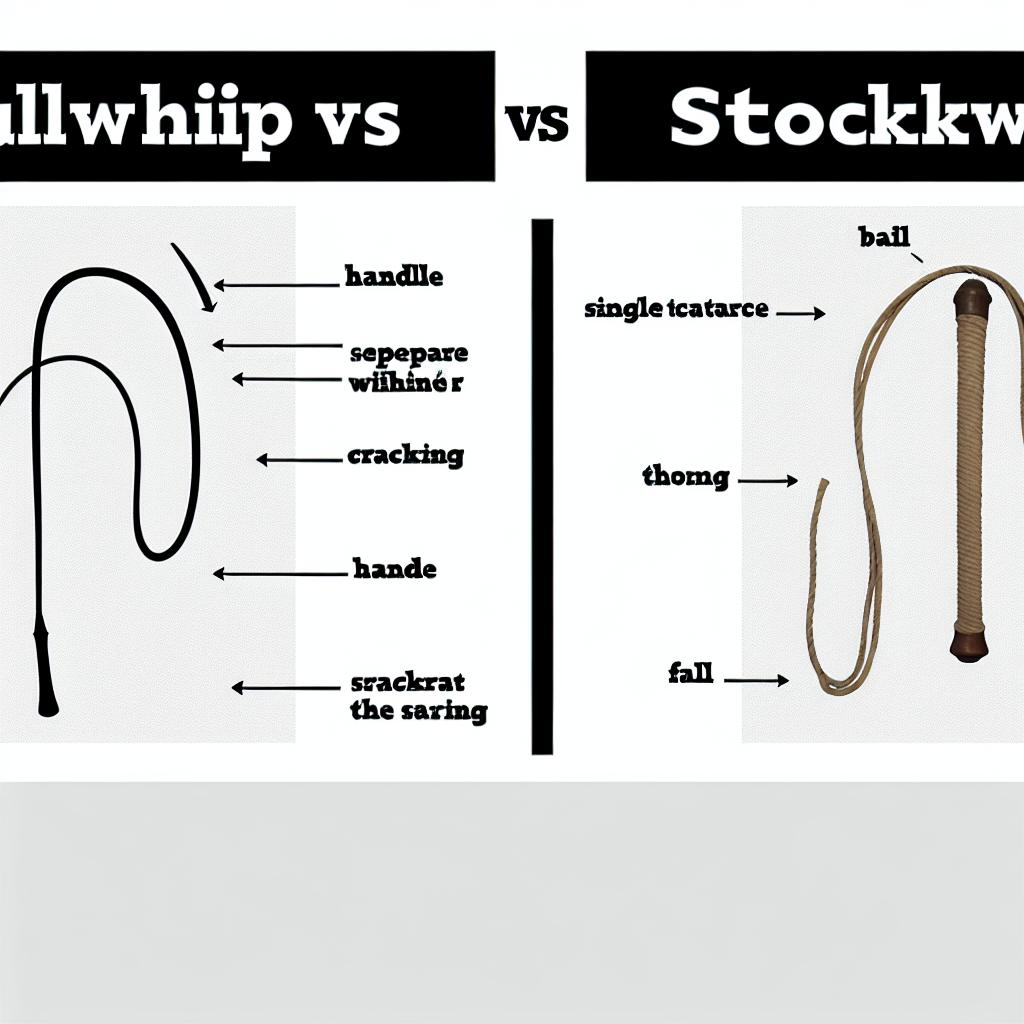
The difference between bullwhips and stockwhips.
Understanding Bullwhips and Stockwhips
When it comes to the topic of whips, two prevalent types often come up: bullwhips and stockwhips. Although they may appear similar at first glance, there are distinct differences in their construction and uses. Gaining a better understanding of these variations can be crucial for making an informed decision when selecting a whip for a particular use.
Characteristics of Bullwhips
Bullwhips possess unique attributes that distinguish them from other types of whips:
Structure: A bullwhip typically features a remarkable design with a thick, solid handle and a long, gradually tapering lash. Unlike some other whips, the handle is generally much shorter than the lash, offering greater flexibility and control. The distinctive structure of a bullwhip allows for a variety of maneuvers and helps the user achieve precision in its use.
Versatility: The applications of bullwhips are numerous and varied. While they are deeply rooted in traditional cattle driving, their versatility has expanded their use into other areas, such as entertainment and sports. The design of the bullwhip makes it suitable for a range of activities that require precise motions and the production of loud cracks. These features make bullwhips appealing for both functional tasks and performance shows, underscoring their adaptability.
Materials: Historically, bullwhips have been crafted primarily from high-quality leather. However, modern advancements have introduced synthetic materials into their construction, offering advantages in terms of durability and cost-effectiveness. The choice of materials affects the overall performance, maintenance, and longevity of the whip.
Characteristics of Stockwhips
Stockwhips present a different set of distinctive features compared to bullwhips:
Structure: One of the primary differences between stockwhips and bullwhips lies in the length of their handles. Stockwhips are designed with longer handles, which provide enhanced control, especially over greater distances. The lash connected to the handle is typically more lightweight and can reach considerable lengths, making it suitable for specific tasks.
Usage: The primary function of stockwhips is in the field of animal husbandry. They are uniquely tailored for leading and managing livestock, allowing handlers to exercise control without the need for close physical contact. The extended reach enabled by their design is particularly beneficial for herding and managing animals across expansive areas or in rugged terrains. This precision and control are critical in maintaining the efficiency and safety of livestock management operations.
Materials: Much like bullwhips, stockwhips are traditionally crafted from leather. However, the use of synthetic materials is also prevalent, especially in modern designs, to withstand the rigors associated with outdoor use. These materials provide resilience against environmental factors, ensuring the whip’s durability over time.
Comparing Bullwhips and Stockwhips
In comparing bullwhips and stockwhips, it is evident that notable differences arise in terms of design and the specific contexts in which they are used.
Bullwhips: Their design, characterized by a short handle and a long, heavier lash, is geared towards more forceful and dynamic actions. The formidable presence of bullwhips makes them a popular choice in sports and performances, where the visual and auditory elements can captivate audiences. The crack of a bullwhip, executed with precision, can be an impressive spectacle, illustrating the blend of artistry and skill required in its use.
Stockwhips: These are specifically designed to prioritize control over longer distances, as demonstrated by their elongated handles and lighter lashes. In animal husbandry, where managing large herds over vast spaces is commonplace, stockwhips excel in providing the necessary reach and dexterity. They serve as an effective tool for moving livestock efficiently and safely, minimizing stress on both animals and handlers.
Choosing the Right Whip
The selection of the appropriate type of whip largely hinges on the specific use case:
If the primary requirement is precision and control over larger distances, particularly essential in the context of livestock management, a stockwhip emerges as the ideal choice. Its design optimally supports tasks that demand intricate control and responsiveness at range.
In scenarios where tasks require more visual and auditory impact, such as in theatrical displays or sports exhibitions, the choice of a bullwhip might be more advantageous. The sharp cracks and dynamic motions achievable with a bullwhip make it suitable for captivating performances.
Further Information
For those seeking further elaboration on the intricacies of whip construction and usage, delving into resources provided by reputable sources or specialist retailers can be beneficial. These outlets often furnish comprehensive information on whip maintenance and proper technique, which can be valuable both for newcomers and seasoned whip users. There is a wealth of additional resources available through specialty suppliers and whip manufacturers, providing insights into best practices for using and caring for whips.
By acquiring a clear understanding of the fundamental distinctions and specialized features of bullwhips and stockwhips, prospective buyers can make informed choices that align with their specific requirements and preferences. This knowledge empowers users to select whips that are well-suited to their needs, whether for practical applications in animal management or for artistic endeavors in sports and entertainment settings.